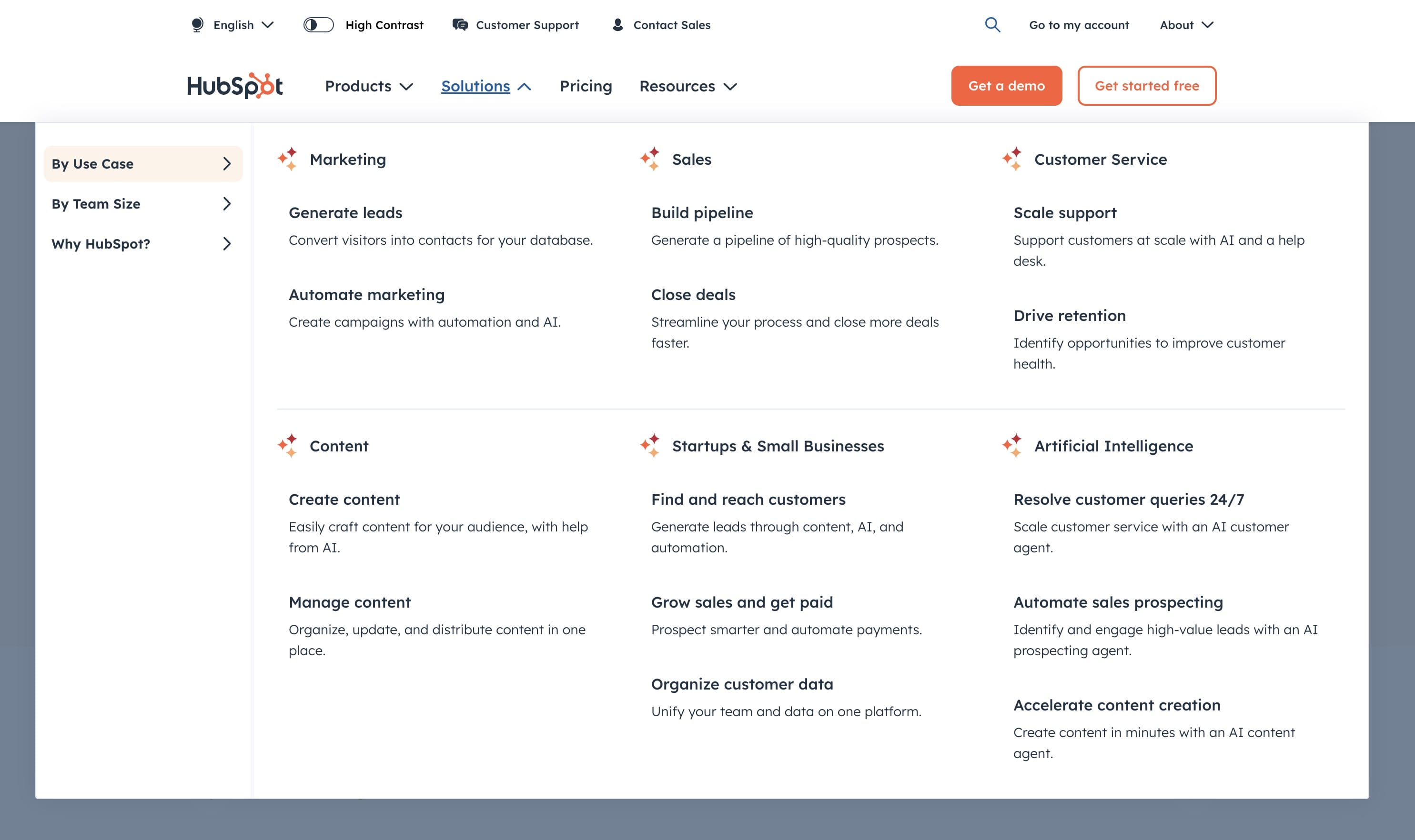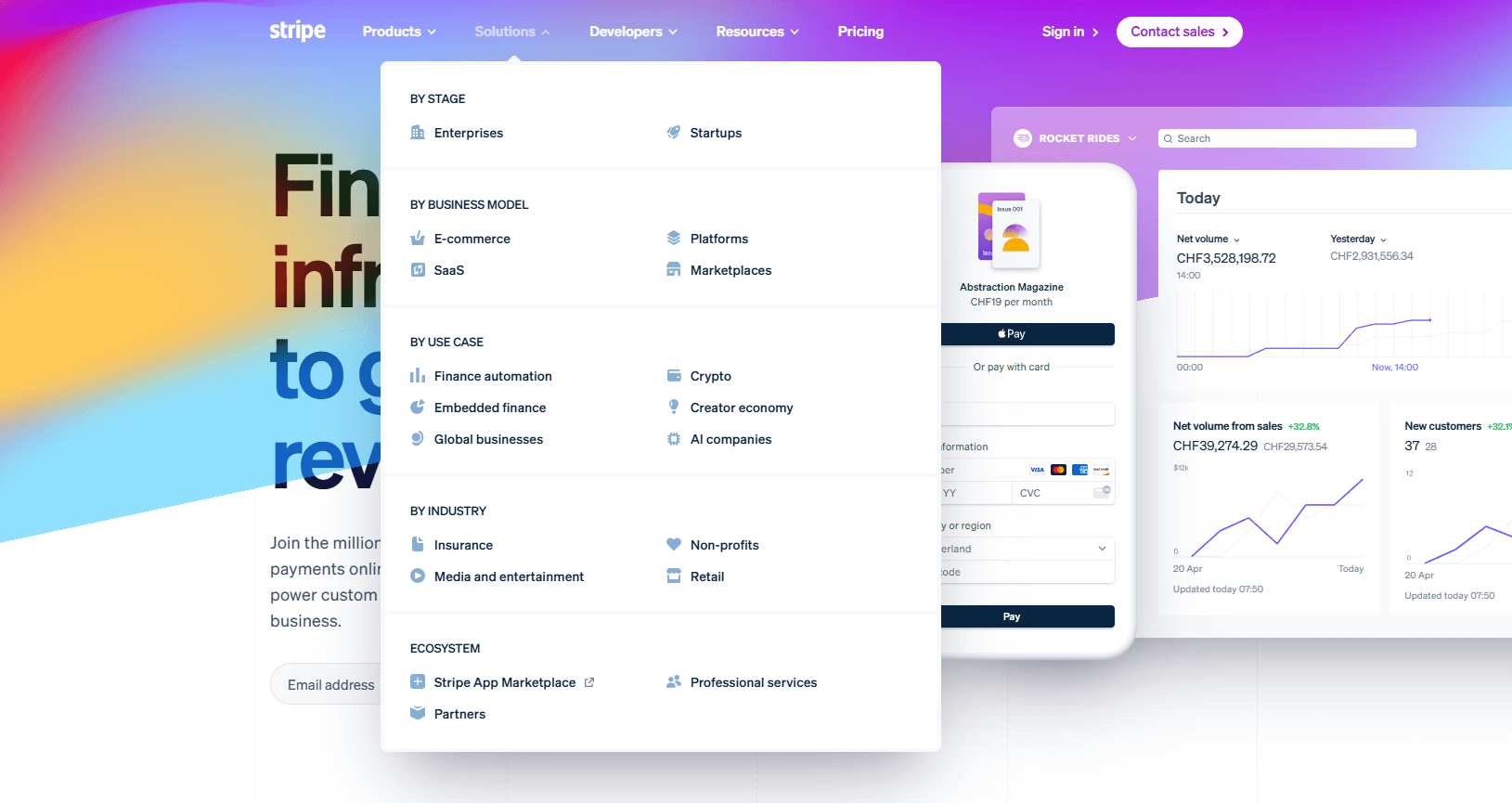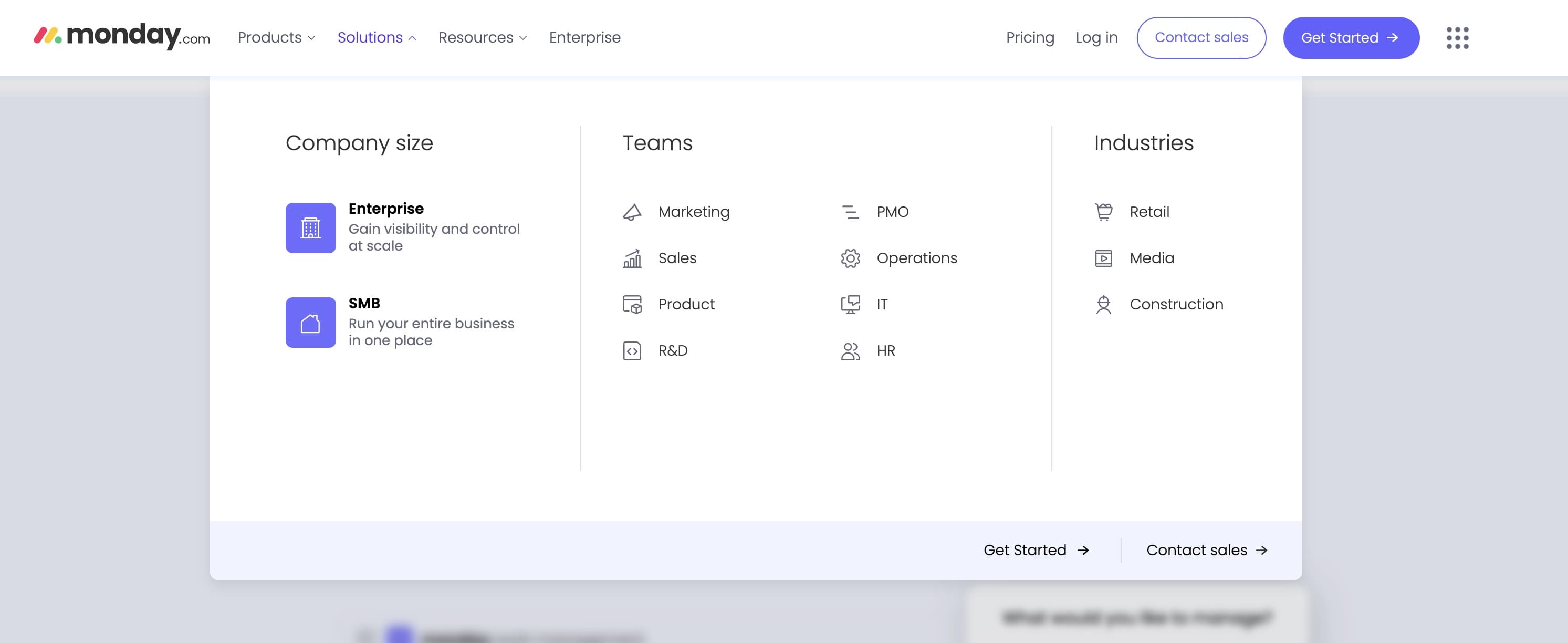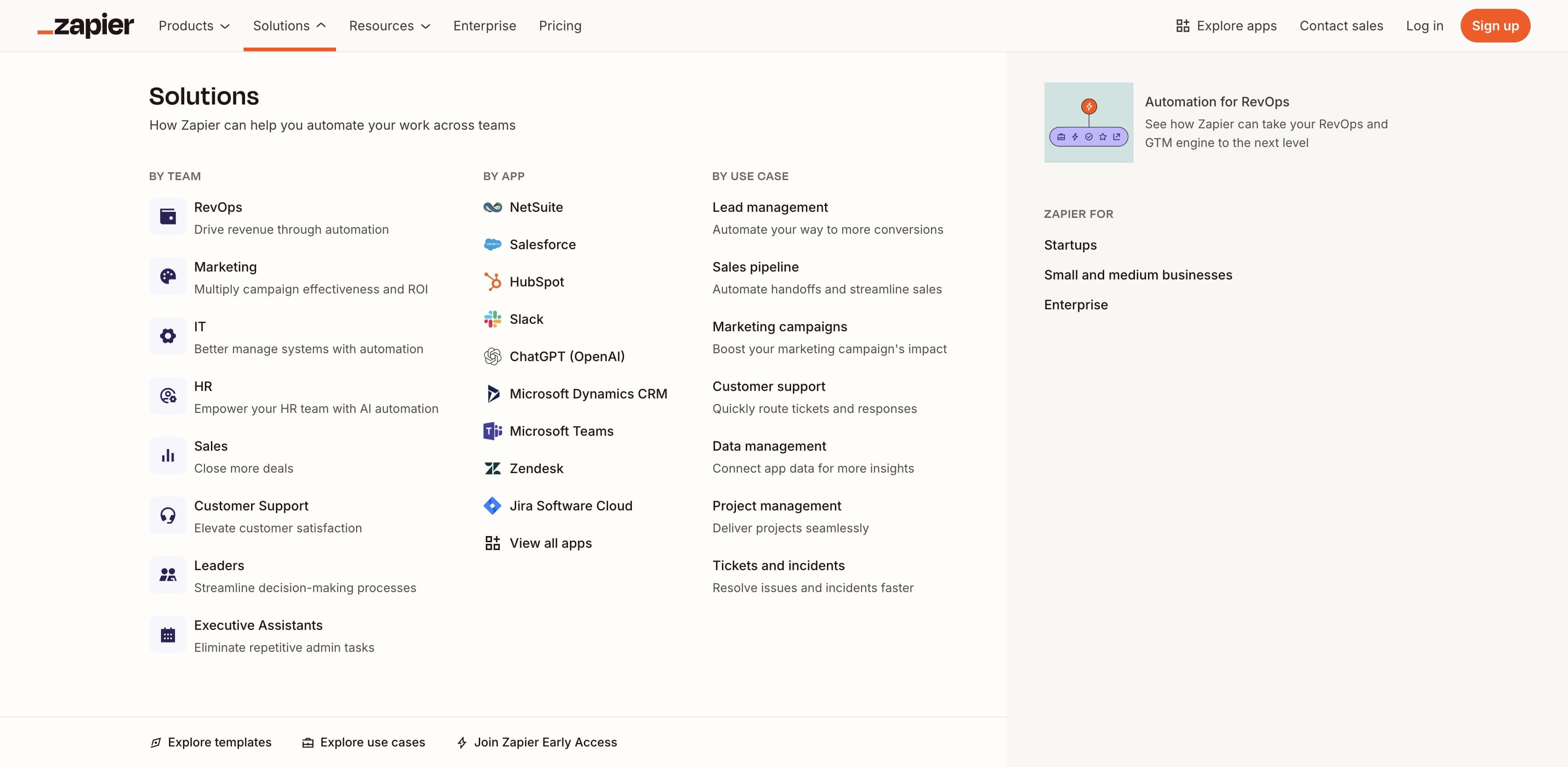Website navigation for a complex SaaS product structure
When a SaaS product grows beyond solving one problem for a small audience, creating user journeys becomes a hassle. You’ve shipped a lot of new features, broke the $1M ARR ceiling, and the growth has stalled. Your website won’t fix that on its own, but it needs shift gears to support further growth.
Written by Dawid ZimnyIt is at this stage that your “Product” dropdown becomes bloated. It became so many things to so many people that their very first interaction creates friction.
Are mega menus a problem for complex products?
Mega menus are a natural step for a complex product structure. The challenge doesn’t lie in the shape of your mega menus or the navigation bar itself. Most mistakes happen when an old, flat website structure is forced into a large navigation.
The same pages that worked pre-$1M ARR are likely not enough at this stage. Horizontal product growth should automatically drive vertical growth of your pages. This requires more elaborate user journeys on your website.
At this stage, simply listing all your products isn’t enough. You’ve had a period of growth and development, which means you also have a ton of data. If you haven’t already, now is the time to use it wisely and create a new website structure.
But how?
On the first day, the marketer talked about the product…
If it wasn’t clear already, we’re not getting rid of the “Products” tab. People will still search, browse, and buy via the product route. It’s a useful bucket and major SaaS and tech websites have it in their navigation.
The user journeys of Product pages become extremely expansive. It’s not a flat structure anymore. Each Product page is longer and more comprehensive. They now link to several niche pages about individual product features.
Which brings us to the thing that needs to change.
On the second day, the marketer added use cases 💡
At some point, any product – and even a service – becomes too complex to comprehend by just saying “what” it is. With a vast or highly modular offering, prospects won’t browse the website to dot all the i’s and cross all the t’s. By adding Use Case pages, you’re giving them a shortcut to what they need.
And the best part about them is that for a complex product, it’s easier to maintain many Use Case pages than a few Product pages. That’s because the use cases are essentially BOFU pages. They rely on being hyper-relevant and don’t require building out intricate user journeys. This is a stark contrast to what we just said about your existing Product pages.
How to use and measure user journeys based on use cases?
The metric of success is direct conversion rate from the use case pages. These pages should NOT be vehicles to drive more people to product pages.
Use cases are standalone BOFU pages and should be treated almost like a landing page. Some links to other pages will be necessary when the context requires them, but the goal is to capture the warm traffic and get qualified leads.
How many use case pages should you have?
When you reach this stage, you’ll usually have a few unique use cases, with a few needs each. It’s a natural progression that anyone exceeding a million in ARR can expect.
But the exact number will depend on one other thing – the structure you choose for the Use Case navigation on your website. Here are the options you can choose from.
Types of use case mega menus for a complex SaaS product
Our list covers the seven most popular options. These are a great starting point for B2Bs and SaaS & tech.

Segment by ICP
This is one of the first shouts in any website meeting. ICP segmentation is as BOFU as it gets. It’s the easiest to execute for SLGs which have a ton of insights from sales calls. For other types of companies, executing website segmentation by ICPs requires a lot of high-quality research. Targeting ICPs as a product-led company might be less reliable.

Cast a wider net – segment by function
Function segmentation is a step above ICPs. It’s extremely powerful for companies with less direct data about their ICPs. It’s a common solution if your business doesn’t rely on the volume of clients, or if you have several ICPs per function.
If we take the marketing function as an example, the ICP segmentation could easily involve a few personas – from marketing managers, all the way to CMOs. All of these ICPs have slightly different requirements. With limited data on how they buy from companies like yours, your best bet is grouping them as a function and finding common denominators.

Segmentation by requirements
The next option focuses on the goals, outcomes, and challenges. If we take a CRM as an example, the requirements of buyers can range from customer support, all the way to lead generation. What’s even more important is that these requirements often transced a single team. As an example, a CRM lead gen form can be useful for sales people, marketers, and even the user’s advertising agency.

Combine ICP & function segmentation with requirements
Perhaps the most popular option combines the first three examples. It segments by either ICP/function AND requirements. In this scenario, the ICP pages are slightly higher up the funnel and they naturally link to the requirements pages.

Segment by company size or revenue
Segmentation by company size is hard to execute but it brings great results if done right. We recommend it as a secondary user journey – as long as you can confidently execute it. Not every business model requires segmentation by company size so don’t add it just to tick a box. If your value prop doesn’t change significantly based on the size of your customers, this split won’t have any benefits.

Segment by the clients’ industry
Sticking to the example of CRMs, a marketing agency won’t use a CRM the same way a DTC e-commerce businesses will. We see industry segmentation used equally as a primary filter for the user journey, as well as a complementary one.

Segment by the industry your clients serve
As an extension of the above, a marketing agency selling to small businesses has different requirements than those working with enterprises. The difference can be as simple as legal compliance, but it’s there.
A good example is working with companies in the transport industry. A buyer shipping building materials will need different assurances than those working with groceries or hazardous materials. If you can recognise these differences among your clients, keep it in mind as a secondary use case journey.
Examples of website menus with a complex product structure
The first example comes from HubSpot. They segment by the combination of function+requirements (#4 on our list), with secondary segmentation by team size (#5).

Stripe goes all-in on segmentation. They use three segment types from our examples:
- Company stage (#5)
- Requirements (#3)
- Industry (#6)
They also add a bucket that works for them – the prospect’s business model. It’s something irrelevant for products like a CRM, but for a payment processor like Stripe, a small marketplace has vastly different requirements than a major eCommerce platform.

Monday, the project management platform, has yet another approach to use cases. They segment primarily by team size (#5), function (#2), and industry (#6).

Finally, Zapier goes beyond the navigation with their use cases. They have a CTA to “Explore use cases” that leads to a standalone page.

Originally published Aug 25, 2025 10:21:07 AM, updated September 30 2025.

